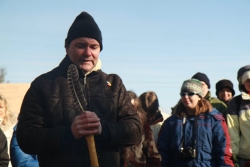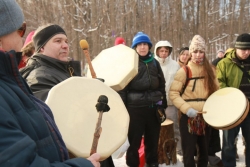DominionSections
Browse Articles
- IndependentMedia.ca
- MostlyWater.org
- Seven Oaks
- BASICS Newsletter
- Siafu
- Briarpatch Magazine
- The Leveller
- Groundwire
- Redwire Magazine
- Canadian Dimension
- CKDU News Collective
- Common Ground
- Shunpiking Magazine
- The Real News
- Our Times
- À babord !
- Blackfly Magazine
- Guerilla News Network
- The Other Side
- The Sunday Independent
- Vive le Canada
- Elements
- ACTivist Magazine
- The Tyee
- TML Daily
- New Socialist
- Relay (Socialist Project)
- Socialist Worker
- Socialist Action
- Rabble.ca
- Straight Goods
- Alternatives Journal
- This Magazine
- Dialogue Magazine
- Orato
- Rebel Youth
- NB Media Co-op
Radio
Saving the Land, Saving History
March 16, 2011
Saving the Land, Saving History
Questions of archeological and spiritual significance rally community to protect Beaver Pond Forest
 Algonquin Daniel Bernard leads a prayer in front of the Sacred Fire during the Pray for the Land event at Beaver Pond Forest on January 30, 2011. The event was part of a campaign to save the area—which many argue is environmentally unique—from new housing developments. Photo: Ben Powless
Algonquin Daniel Bernard leads a prayer in front of the Sacred Fire during the Pray for the Land event at Beaver Pond Forest on January 30, 2011. The event was part of a campaign to save the area—which many argue is environmentally unique—from new housing developments. Photo: Ben Powless

OTTAWA—On the last day of the first month of the UN-declared Year of the Forests, clear-cutting began on the Beaver Pond Forest (BPF), a section of the sacred and ecologically-unique South March Highlands (SMH) in the west end of Ottawa. Since January 31, 2011, 100-year-old trees have been cut, animals have died, and the living legacy of a potentially 10,000-year-old cultural site is being destroyed.
All this is occurring despite broad-based opposition from a coalition of local residents and community associations throughout the city, Algonquin First Nations communities, and several high-profile national organizations like the Sierra Club Canada and the David Suzuki Foundation.
According to Paul Renaud of South March Highlands-Carp River Conservation Inc (SMHCRC), the SMH is “the last wilderness area inside the urban boundary of Ottawa. It’s an area that’s incredibly biodiverse—it is home to 20 documented species-at-risk. If we cannot protect a small forest that’s unique in the world, [one] that has all these strong and compelling reasons to protect it, what hope do we have for all the other places that are vital to the maintenance of the environment that we require?”
 A drum circle closes a day of occupation at Beaver Pond Forest. “[This forest] is a living temple...and...demands immediate protection and reverence,” says Algonquin elder Grandfather William Commanda. Photo: Ben Powless
A drum circle closes a day of occupation at Beaver Pond Forest. “[This forest] is a living temple...and...demands immediate protection and reverence,” says Algonquin elder Grandfather William Commanda. Photo: Ben PowlessThe BPF section of the SMH is being cut in order to turn the area into a subdivision built by KNL Developments, a partnership between Urbandale Corporation and Richcraft Homes. Last-ditch efforts, such as two Algonquin warriors chaining themselves to trees, a sit-in at the mayor’s office, and about 20 activists forming a circle around a tree cutting machine, were the latest in a 30-year fight to protect the forest.
“The [BPF] clear-cutting is a violation of Algonquin law,” said Bob Lovelace, former Co-Chief of the Ardoch Algonquin First Nation. Lovelace, along with Daniel Bernard of the Amikwabe (Beaver) Clan, chained themselves to trees in an effort to stop the clearcutting.
“What we did was a natural response [to] the violence that is actually carried out against Algonquin First Nations, but also against the actual living things in there,” said Bernard. “The hundreds of thousands of animals that are actually living there and hibernating, this is their homes.”
The city is required by its Official Plan to acquire and protect environmentally sensitive areas, but says it does not have the money to do so in the case of BPF. Concerned residents of the area came up with a tentative stewardship plan to buy the land, which the outgoing city council considered as an option, but after a fall 2010 municipal election and with the developers not wanting to sell, the new council gave final approval to the development, saving a mere 80-metre-wide wildlife corridor to link natural areas on either side of the subdivision.
Before the cutting began, revered Algonquin elder Grandfather William Commanda declared, “This is a living temple, a place of Manitou, a special place of nature, and that precious reality also demands immediate protection and reverence.”
Spurred by Commanda’s words, Bernard led a one-day sacred fire ceremony at the forest in mid-January 2011, and a few days later, on January 19, he started a sacred fire at an entry point to the forest, a fire that burned for 11 days and was tended around the clock.
Bernard also held a four-day sacred fire at Queen’s Park in February, taking the message to the doorstep of the provincial government, who many felt had the responsibility to issue a stop-work order to allow for further archeological studies of the forest.
An archeological assessment for the developers was done by archeologist Nick Adams in 2003, as part of the approval process for the subdivision.
Between 11,000 and 9,000 years ago, the BPF area was an island, while much of what is now Ottawa was beneath the Champlain Sea.
Dr Robert McGhee, past President of the Canadian Archeological Association and recipient of the Massey Medal of the Royal Canadian Geographical Society, conducted a review of Adams's assessment in 2010 and found what he termed a "fatal flaw": in his study, Adams had dismissed any potential for historical, pre-European-contact archeology on the site. Another review, led by a prominent local archeologist Dr Marcel Laliberte, echoed McGhee's concern and called for further study to be done in the area.
In addition, according to Renaud, “In 2005 [archeologist] Ken Swayze published a report showing a significant find adjacent to the KNL property that is estimated to be 10,000 years old.”
The city and province both have legal processes to stop the cutting and order more studies, but neither has acted on any of the post-2004 information, and each states that it is up to the other level of government.
The most recent archeological development is a February 13, 2011, paper from American historian/archeoastronomer William Sullivan, who judges a very high probability that the SMH could be a World Heritage Site, based on its characteristics and an analysis of a circle of stones found in the forest in 2010.
Ottawa is situated on the Kitchissippi (Ottawa) River, which starts over 1,000 kilometres northwest of the city and serves as the Ontario/Quebec provincial border as it flows down to the St Lawrence River. The lower part of the river’s watershed is recognized by many as the unceded and unsurrendered traditional territory of the Algonquin.
The government has a “duty to consult” with the Algonquin under Section 35 of the Canadian Constitution, as well as under the UN Declaration on the Rights of Indigenous Peoples. The courts’ interpretation of the constitutional duty is that the government must uphold the honour of the Crown in consulting with Aboriginals—this responsibility does not rest with the developers. The province, on the other hand, has not consulted at all, and the city has only consulted in efforts to foster dialogue between the developers and the “Algonquins of Ontario.”
The “Algonquins of Ontario” (AOO), who are participating in a land claims process, do not represent all Algonquins in Ontario. Five eastern Ontario Algonquin First Nations not part of AOO sent letters to the government, asserting their own right to consultation, but they were ignored. Even Commanda’s letters to the city and province were only met with generic responses, despite his key position among the Algonquin people and the fact that he was awarded the Key to the City of Ottawa in 2006.
The fact that Aboriginal and non-Aboriginal communities are uniting over the protection of BPF makes it similar to other instances of resistance to development projects in eastern and southern Ontario over the past few years. This includes protests against a highway through the Red Hill Valley in Hamilton; a dump (Site 41) in Simcoe County, north of Toronto, that threatened the underground water supply; a business park development in Hanlon Creek, Guelph; and uranium exploration in Robertsville, about an hour east of Ottawa.
Shared characteristics of these battles include efforts over many years at dialogue with government (without much success), followed by direct actions in a final effort to stop imminent environmental destruction.
Mireille Lapointe, who became Co-Chief of the Ardoch Algonquin First Nation midway through the opposition to the uranium exploration in their territory, has come to see a bigger picture at work in these situations. “I think that the new colonialism is corporate colonialism, and we are all under this corporate colonialism," said Lapointe. "Where we [Aboriginal people] have experienced colonialism over a long period of time, I think non-Aboriginal people are now experiencing this colonialism and they’re realizing that the laws that are on the books are not really protecting them nor the environment that they want to protect, and I think that a lot of people are bewildered and wondering how this could happen.”
For more information on the efforts to save the South March Highlands, please see www.ottawasgreatforest.com, www.southmarchhighlands.ca, and www.union-algonquin-union.com.
Greg Macdougall is active in education, decolonization and community/activist infrastructure initiatives in Ottawa. His writings, including a printable Aboriginal Understanding booklet, can be found at www.EquitableEducation.ca.
Related articles:
By the same author:
Comments
Archived Site
The Dominion is a monthly paper published by an incipient network of independent journalists in Canada. It aims to provide accurate, critical coverage that is accountable to its readers and the subjects it tackles. Taking its name from Canada's official status as both a colony and a colonial force, the Dominion examines politics, culture and daily life with a view to understanding the exercise of power.